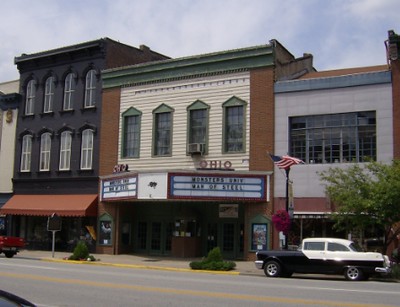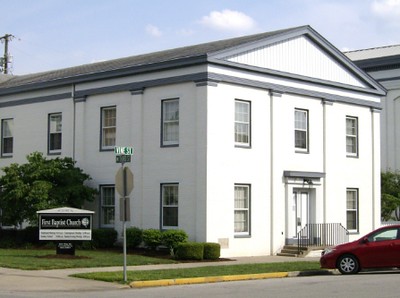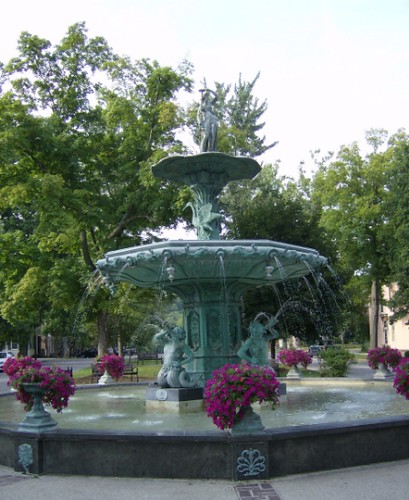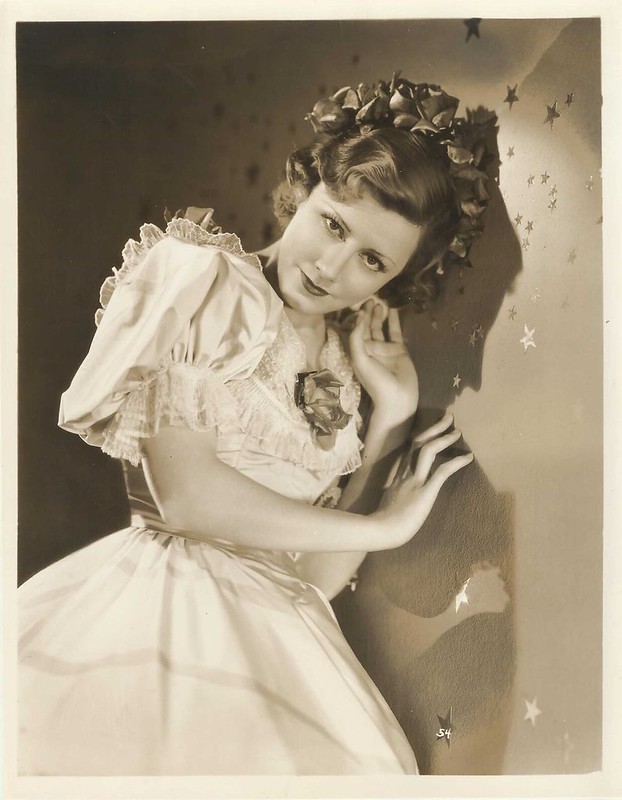On May 29, 2014, the Park Ridge Public Library will remember actress Irene Dunne with a visit from her granddaughter, Ann-Marie Streibich. Ann-Marie will speak about Irene’s life and career and will answer questions from the audience prior to a screening of Theodora Goes Wild.
The following was originally published in The Rediscovered movie blog:
http://therediscovered.wordpress.com/
To walk down West Second Street is to travel back into time. It’s a street like many others in Madison: historic and nostalgic. However, there was one thing that separated it from the other streets. My whole reason for driving 300 miles from Chicago into southeastern Indiana was to see one particular house. It’s not that this house is any more spectacular than others in town. It was simply a matter of who had lived there.
“Could you tell me where the Irene Dunne home is?” The question must’ve been asked enough times because the lady behind the desk in the Visitor’s Center made only the slightest pause. She told me to walk up Vine Street (where the Center is located) and continue past West First Street until I got to Second, then make a left and continue on until I got to the 900 block. The home was within walking distance.
So many homes in the rivertown of Madison are of architectural interest. You see this immediately when you drive into the downtown district. Sections of it seem to be isolated in time. Madison was settled back in 1809 when Indiana was still a territory, so there is a lot of history everywhere you turn. In fact, Madison prides itself in having “the largest historic district in Indiana and the largest contiguous National Historic Landmark District in the US.” One hundred and thirty three blocks of it to be exact. Many stately homes lined the avenues. Dense gardens and mossy statuary filled the backyards. These homes were designed in every style– from Colonial and Georgian to the Italianate and Greek Revival. As I walked down West Second Street, it was like being in small-town Victorian America. For many, I suppose, that conjures up musty tradition. For me, I felt a sense of belonging.
I heard music that took me back to what it must’ve been like at the turn of the century. I couldn’t tell at first where it was coming from. I know I didn’t imagine it. It was like the music from an ice cream truck that never came around the corner. It just floated there in the air, in one place. The music was different though. That much I could tell. It was like calliope music. I knew it must’ve been coming from somewhere down by the river.
The Ohio River was only a few blocks away from where I was. A couple blocks to the left and you’d be at the riverfront. Though I never found the source, I remembered the lady in the Visitor’s Center had told me a steamboat was visiting. I gathered the music was from that excursion boat, which must’ve been making its stop on a tour of the river. Before the Civil War, Madison boomed in business. It was a main thoroughfare for riverboats.
The Madison-Indianapolis railroad, which had been built during the 1830s and 1840s, passed through what was then a prosperous town. But after the war, as more avenues in commercial trade opened up, the town slowly diminished in relevance and became overlooked by the decades; its glory days of the steamboat passed into history. The railroad itself is gone now, but one can still find the old tracks in a park near the riverfront. Today, there is a railroad museum, and of course, all the popular attractions of the river. It took the tourist trade of the 20th century to bring the town back.
Vintage postcard, 1916. (The same year Irene graduated high school.)

Irene Dunne’s father, Joseph J. Dunn, had been a steamboat inspector. Her mother, Adelaide, a talented pianist. Both were natives of Kentucky. It was in Louisville, in 1898, where their only daughter was born. A son, Charles, would follow two years later. The family story goes that one of Irene’s four aunts had suggested her name. The riverboat had been especially important in the life of Irene Dunne. She was almost born on one while the family was on their way to Madison, where Adelaide’s family resided. Instead, the Dunns had to disembark in Louisville. One of Irene’s fondest memories as a child was riding on the steamboat with her father, “Captain Dunn,” as he was known from one end of the Mississippi to the other.
“I will never forget a trip down the Mississippi to New Orleans with Father and Mother in one of the old river boats. We had the captain’s suite and because of my father’s position everything imaginable was done to make us feel important. I was so excited. I loved the boat and the lazy river…”
Her father was a positive influence in her life, and he instilled in her a strong sense of morality– something that she would carry with her for the rest of her life. She was that rare breed who exhibited character both on and off screen. There was a reason why she became known as the “First Lady of Hollywood.” There was always a quiet dignity about her. There were no scandals. No divorces. She stayed married to the same man, Frank Griffin, until his death. She never remarried. She knew the value of marriage and what it meant to make a commitment. Her values can be traced back to the example her father had set.
“Happiness is never an accident,” her father had told her. “It is the prize we get when we choose wisely from life’s great stores. Don’t reach out wildly for this and that and the other thing. You’ll end up empty handed if you do. Make up your mind what you want. Go after it. And be prepared to pay well for it. I hope that you’ll go after the rooted things– the self-respect that comes when we accept our share of responsibility. Satisfying work. Marriage. A home. A family. For these are the things that grow better with time, not less. These things are the bulwarks of happiness.”
Irene was only fourteen when her father died. Afterwards, her mother moved the family to Madison, which is situated about 55 miles northeast of Louisville. In those days, according to a 1910 census, the population was nearly 7,000. Here, Irene’s family lived next door to her grandparents and other relatives on her mother’s side. In these years, Adelaide helped develop her daughter’s singing with music lessons.
While in Madison, Irene was still connected to the river life she had known with her father. Those memories they had shared never left her. A hundred years later you can imagine tracing her steps to Vaughn Drive and the banks of the Ohio. In her time, there were show boats with entertainers that passed through. “We used to sit on the hilltops and wait for them to come ’round the bend in the river with the calliope playing the popular tunes.” Her life would be entwined with the lore of the steamboat years later in her professional career.
Allan Jones and Irene Dunne, Show Boat (1936).

Of course, there were glaring reminders that times had greatly changed. At the corner of one block was an electrical power station. Further along, in the far distance of the valley, one could see the chimneys of the Clifty Creek Power Plant. It was built in the 1950s with two of the tallest chimneys in the world. It’s not a proud distinction since the power plant is also ranked as one of the dirtiest in the country. But by and large, the neighborhood has been preserved. I learned that the Irene Dunne home was recently sold. We hope it will be left as it is. Her birthplace in Louisville, on the other hand, hasn’t been as fortunate. Her first home at 507 East Gray Street is now a parking lot.
I was very happy when I found the house on West Second Street. The emotion was clearly reflected in the number of pictures I took of the home from my vantage point on the sidewalk. I’m sure that had I been anywhere else, this might’ve caused some curiousity from neighbors, like the man sitting on his steps across the street. But I’m sure they’ve seen it before. It’s a testament to a star’s legacy that there are still fans who turn up to sightsee and take pictures. We continue to reach up to those stars of the past. Even if their names are half-forgotten and their films never play on cable, there is still a glow where they had once been. It shines brighter than what has taken their place in the here and now. I don’t think a hundred years from now anyone will have interest in where Jennifer Aniston or Angelina Jolie grew up.
There was a plaque near the doorway that read: “Homeplace Irene Dunn 1898-1990.” That was not an error because her family name is originally spelled Dunn; the “e” was first associated with the name around the time of high school. Besides the house and the street, I also took a photo of the nearby tree that towered overhead. I pictured that aged tree a hundred years younger when it stood before the Dunn household.
One of the few things still living from a century ago…

“We lived a leisurely life in that small town. There was time for everything. Time for me to dream my dreams under the Heaven Tree that stood in our yard, time for music around the piano in the evenings, time for reading wonderful books, time for friendship.”
When I returned to the Visitor’s Center, I stopped in the adjacent research library where the custodians provided me with a file on Irene Dunne. There were many press clippings and articles, including a copy of an article in Modern Screen (December 1938) called: “Irene Dunne’s True Life Story With Her Exclusive Childhood Pictures.” In the folder I saw the business card of Wes Gehring, author of the most recent biography on Irene called Irene Dunne: The First Lady of Hollywood (2006). When I was finished, the archivist asked if I was from out of town. I mentioned that I was from Park Ridge, Illinois, and then he told me he had lived in Norwood Park in Chicago. After I left I realized that this gentleman must’ve been Ron Grimes, co-author of one of the books in the “Images of America” series. He had written a book called Madison, and I remember reading that he now worked in Madison’s research library. Ron had suggested I talk to the owner of the Ohio Theatre, who himself was an avid collector and admirer of Irene Dunne.
The Ohio Theatre can be found at 105 E. Main Street in the heart of the historic downtown district. It was originally built in 1938. Irene Dunne had returned to Madison that year for the grand opening of the theatre. But its days of premieres were now in danger. The theatre is in need of a renovation. In fact, there is a current “Save the Ohio” campaign with the goal of upgrading the theatre. They hope to gather enough funds to convert the film projection to digital. I spoke to the owner, Tony, who, like the other townspeople I had met, was very friendly and helpful. He mentioned the support the town had received from Irene’s grandson, Mark Shinnick, who had donated some of the items to the historical society. I mentioned to Tony that I was planning to have Irene’s granddaughter– Mark’s sister, Ann-Marie– as a special guest in Park Ridge in 2014.
I asked him whether he currently had any Irene Dunne items on display in the lobby, but he did not. He does have a large collection of Irene Dunne memorabilia, but in my eyes his greatest contribution to the memory of Irene Dunne is not a prop or personal item. It’s the marker in front of his theatre. It was installed in 2006 by the Indiana Historical Bureau and the Friends of Irene Dunne. The text reads:
IRENE DUNNE
Born in Louisville, Kentucky 1898; after father’s death, moved with family to Madison. Graduated from Madison High School 1916. After voice training in Indianapolis and Chicago, began singing professionally. Won lead in road show of Florenz Ziegfeld’s Show Boat 1929. Began Hollywood career 1930; in 42 films; nominated for five Academy Awards…
Dunne maintained ties with Madison, which has honored her; she helped with restoration of Broadway Fountain 1976. She received Laetare Medal from University of Notre Dame 1949. President Dwight Eisenhower named her an alternate delegate to United Nations General Assembly 1957; was Kennedy Center Honors Awardee 1985. Died 1990 in Los Angeles.
Some of those 42 films include The Awful Truth (1937), My Favorite Wife (1940), and Anna and the King of Siam (1946). When she was acknowledged in 1985 at the Kennedy Center Honors, James Stewart told the audience that Irene was the only actress to be nominated three times for three different genres. Unlike some of her equally talented contemporaries, Irene could shine in period melodramas, screwball comedies, or modern musicals. My personal favorite is the 1936 version of Show Boat. I had played this musical on film when I operated the LaSalle Bank Theatre revival house in Chicago. For the film, Irene Dunne recreated the role of Magnolia Hawks, which she had played in the first road tour of Show Boat in 1929. The tour proved to be her catapult for Hollywood. Those who are familiar with the film will always think of her when they hear “You are Love.”
Downtown Madison is a place of carriage rides, street performers, confectioners, and ice cream parlors. It reminded me of Galena, Illinois, near the Iowa border. There is much to see here– so much that I almost didn’t notice what was directly under my feet. Outside the theatre box office was a Hollywood Walk of Fame-style star on the sidewalk. It commemorated the filming of Some Came Running. This 1950s melodrama starred Frank Sinatra and Dean Martin and was directed by the legendary Vincente Minnelli. The film had been shot in Madison, but it was only an afterthought to me. Perhaps if I had more time, I would’ve visited the locations seen in that film.
Looking for movie locations is one thing, but I was more interested in the things that made Irene Dunne the person she became. Throughout her lifetime, she reflected those tenets of her Christian faith with kindness, generosity, and charity to others. This is a woman who was awarded the Laetare Medal by Notre Dame, which is the highest honor given to a Catholic lay person. Practically no one in the entertainment world is given such an honor.
And so I visited St. Michael the Archangel Church where she had attended Mass with her family. Like the theatre, it was in need of a renovation. It’s no longer active as a place of worship. I thought back to the days when people like Irene made up the congregation that filed through its open doors. Founded in 1837, St. Michael’s is one of many churches in town. In Irene’s time, the church was a respected institution– providing a framework intended to uplift society. She was strongly influenced by its moral guidance and by the spiritual comfort it provided. A hundred years later, we’ve become a more secularized society with modern definitions of family and God, so it’s harder for some to appreciate the value of religion as it was then in small-town America.
Another church I visited was the First Baptist Church, which was established in 1807. Built in the style of the Greek Revival, it was located at the corner of Vine and West Third Street– kitty-corner from John Paul Park (named after the founder of Madison). Like St. Michael’s, the doors of the church were locked, but there were still services here every Sunday. The well-maintained garden and the fresh flowers that hung on the door attested to the fact that it still flourished. It was here where for the first time Irene earned some money for her singing.
Intersecting with Main Street is Broadway. In the middle of it, you will find one of the town’s most striking monuments: The Broadway Fountain. The fountain dates back to 1876 when it made its debut during the Philadelphia Centennial. It was later presented to Madison in 1886. I sat on a bench in front of it for a time with my mother in the late afternoon. Like the town itself, one felt a sense of comfort being there. The Trinity Methodist Episcopal Church was across the street from us on our left. Though it was quiet when we were there, the fountain is often the center of activity, whether it’s a farmer’s market or a Dixieland concert. In the 1970s Irene Dunne helped restore the fountain with a $10,000 donation. It is through her generosity as well as through the contributions of others that the statue still spouts water. And visitors such as myself can still make wishes with lucky pennies.
We stayed at the Hillside Inn, which overlooks the downtown section. It was a wonderful view from the third floor balcony. Off in the distance you could see the general area where her home is situated, surrounded by other homes that have changed little. Steeples and spires could clearly be seen. Closer to the inn, down the steep hill below, were the old frame buildings. Pick-up trucks and motorcycles were always riding through. Around the bend from the inn was Telegraph Hill where, through the years, children have gone sledding in the winter. At one end of the panoramic view before me I could see the Ohio Bridge stretching across the river into Milton, Kentucky. On the other end, in the direction of West Main Street, there was the smoke stack which, like an active volcano, continuously released a slow-moving cloud.
At dusk, a haze settled over the valley. It was the kind of active view you could watch for hours while reflecting on the history. As the night slowly descended on the rivertown, the old buildings of Madison stood in silent silhouette like black ghosts. The hum of cicadas, which seemed to blanket the residential section, took on a different sound when heard from above; it seemed more like a roaring mass with the individual call drowned out. The atmosphere of the environment soaked in. I became more attuned to the world as it once was a century ago.
You feel a presence in that town. Irene Dunne’s been gone for twenty-three years, and her final resting place is on the other side of the country in California, yet part of her is still there. When she died in 1990, she took with her all those happy experiences she had as a child and as a teenager: riverfront walks, 4th of July celebrations, social dances, high school drama performances, moonlit evenings under the Heaven Tree… and so many other memories lost now in time.
Something had compelled me to come here, to drive five hours through Indiana into the Ohio River Valley. By doing so, I gained a better understanding of a time and place that shaped Irene Dunne. She is still remembered and loved by people generations removed. I don’t think anything is greater than being remebered like that. It’s a special kind of legacy to leave behind.
Irene Dunne, Sweet Adeline (1934)
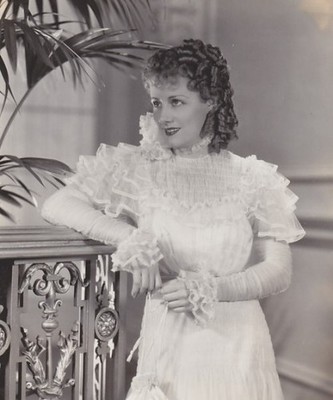
* * * * * * *
There are only two books on Irene Dunne, but both are insufficient as biographies. One is a bio-bibliography that is rather short in length, and the other is not very well written. (Dunne merits a Scott Eyman-type of author who can write the kind of narrative she deserves.) Instead, we encourage you to visit the ultimate Internet source on all things Irene Dunne: http://www.irenedunnesite.com/



